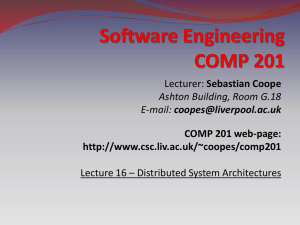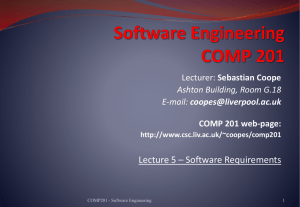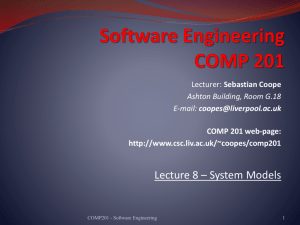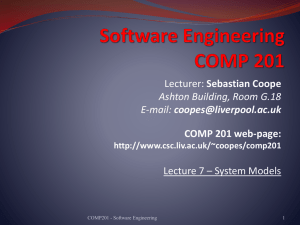SE_L31
advertisement
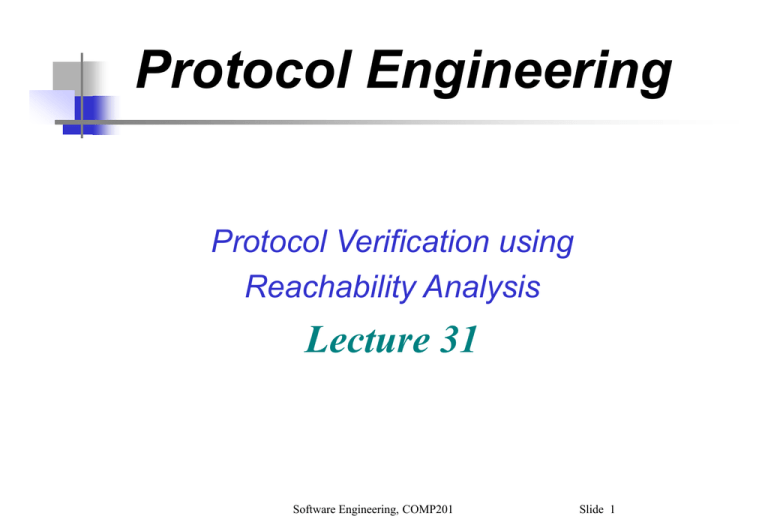
Protocol Engineering
Protocol Verification using
Reachability Analysis
Lecture 31
Software Engineering, COMP201
Slide 1
The Alternating Bit Protocol as
CFSMs
• The Alternating Bit Protocol is used to guarantee
the correct data delivery between a sender and
receiver connected by an error channel that loses or
corrupts messages.
– It got the name since it uses only one additional control
bit in the message and this control bit only alternates
when the previous message is correctly received.....
Software Engineering, COMP201
Slide 2
The Alternating Bit Protocol
Software Engineering, COMP201
Slide 3
Verifying the Alternating Bit
Protocol
• Assume that
– C1 is the outgoing channel of the sender and
– C2 is the outgoing channel of the receiver.
• Let us assume that
– C1 loses the odd numbered messages, i.e., the 1st, 3rd, 5th, and so on,
– while C2 delivers every message.
– Let S be the sender, R be the receiver, and E stands for an
empty channel.
• Let the 4-tuple
(sender state, receiver state, C1 content, C2 content)
represent the global state, a snapshot of the overall
Software Engineering, COMP201
Slide 4
system state.
•
•
•
•
•
•
•
•
•
•
•
•
•
•
•
•
•
•
(1,1,E,E)--S:NewData-->(2,1,E,E) sender receives data, x, from its upper layer
(2,1,E,E)--S:-D0-->(3,1,D0,E) sender attaches a sequence bit 0 after x. D=x
(3,1,D0,E)--C1:lose D0-->(3,1,E,E)
(3,1,E,E)--S:To-->(7,1,E,E)
(7,1,E,E)--S:-D0-->(3,1,D0,E) retransmit D0
(3,1,D0,E)--R:+D0-->(3,2,E,E) This time C1 correctly delivers the message.
(3,2,E,E)--R:DeliverDate-->(3,3,E,E) receiver delivers x to its upper layer
(3,3,E,E)--R:-A0-->(3,4,E,A0)
(3,4,E,A0)--S:+A0-->(4,4,E,E)
(4,4,E,E)--S:NewData-->(5,4,E,E) sender receives data, y, from its upper layer
(5,4,E,E)--S:-D1-->(6,4,D1,E) sender attaches a sequence bit 1 after y. D=y
(6,4,D1,E)--C1:lose D1-->(6,4,E,E) this is the third message received by C1
(6,4,E,E)--S:To-->(8,4,E,E)
(8,4,E,E)--S:-D1-->(6,4,D1,E) retransmit D1
(6,4,D1,E)--R:+D1-->(6,5,E,E) This is the fourth msg. C1 delivers it.
(6,5,E,E)--R:DeliverData-->(6,6,E,E) receiver delivers y to its upper layer
(6,6,E,E)--R:-A1-->(6,1,E,A1)
(6,1,E,A1)--S:+A1-->(1,1,E,E)
Software Engineering, COMP201
Slide 5
Correctness properties of the
protocols
•
•
•
•
•
•
1.
2.
3.
4.
5.
6.
7.
Freedom from deadlocks.
Freedom from unspecified receptions
Liveness
Boundednes.
Freedom from dynamical blockage
Completeness
Self-synchronization
1234
SYNTACTIC
Logical correctness
(properties 1-4).
Dynamic
567
SEMANTIC
Static
Software Engineering, COMP201
Slide 6
Protocol Design Errors
Deadlock
– both at receiving nodes, no msg in channels.
FIFO queries are empty
S
+a1
+a2
+a t
Software Engineering, COMP201
Slide 7
Protocol Design Errors
• Unspecified reception
– at receiving/final nodes, head msg transition labels.
– What happens if you throw away those head msgs
that are not specified?
b1
S
+a1
b2
+a2
+at
br
{a1, …, at}{b1, …, br}=
Software Engineering, COMP201
Slide 8
Protocol Design Errors
• Livelock
– processes keep exchanging messages but not making "effective
progress".
• State ambiguity
– global states with the same process states but different channel
status. (This is a potential error, may not be a real one.)
• Channel buffer overflow.
• Non-executable transitions
<K
– dead code.
Software Engineering, COMP201
Slide 9
Reachability Analysis
• It is a global state exploration process that
– starts from the initial global state and
– recursively explores all the possible transitions that
lead to new global states.
• The result is a reachability graph, which
captures all possible states.
Software Engineering, COMP201
Slide 10
Protocol Verification using
Reachability Analysis
Software Engineering, COMP201
Slide 11
Protocol Verification Exercises
• What are the channel buffer sizes needed for the
following two machines?
Software Engineering, COMP201
Slide 12
Protocol Verification Exercises
• Find deadlock, unspecified reception global states in
the following protocol
There are also non-executable transitions and nodes in the two CFSMs.
How many buffers are required in each of the two channel?
Software Engineering, COMP201
Slide 13
C12
C21
[S0, E, E, S0]
[S1, E, 1, S0]
[State of P1, C21, C12, State of P2]
[S1, E, E, S1]
[S1, 2, E, S0]
[S1, 3 6, E, S0]
[S1, 6, E, S0]
[S1, 3, E, S2]
[S1, E, E, S2]
Software Engineering, COMP201
Slide 14
Pros and Cons of Reachability
Analysis
• Advantages:
– Easily automated.
– Many logical errors can be detected by only examining
individual global states in the reachability graph.
Software Engineering, COMP201
Slide 15
Pros and Cons of Reachability
Analysis
• Disadvantages:
– State space explosion problem.
– Does not work on unbounded protocols.
– Many relationships among the protocol state
variables, expressing the desirable logical correctness
properties of the protocol, are not apparent from
simply traversing the reachability graph.
Software Engineering, COMP201
Slide 16
Homework
Given the following network of two communicating finite state
machines,
a) Perform the reachability analysis on the Network (M, N).
b) What sizes of buffers are needed for the two FIFO channels?
c) Are there non-executable states or transitions?
Software Engineering, COMP201
Slide 17




